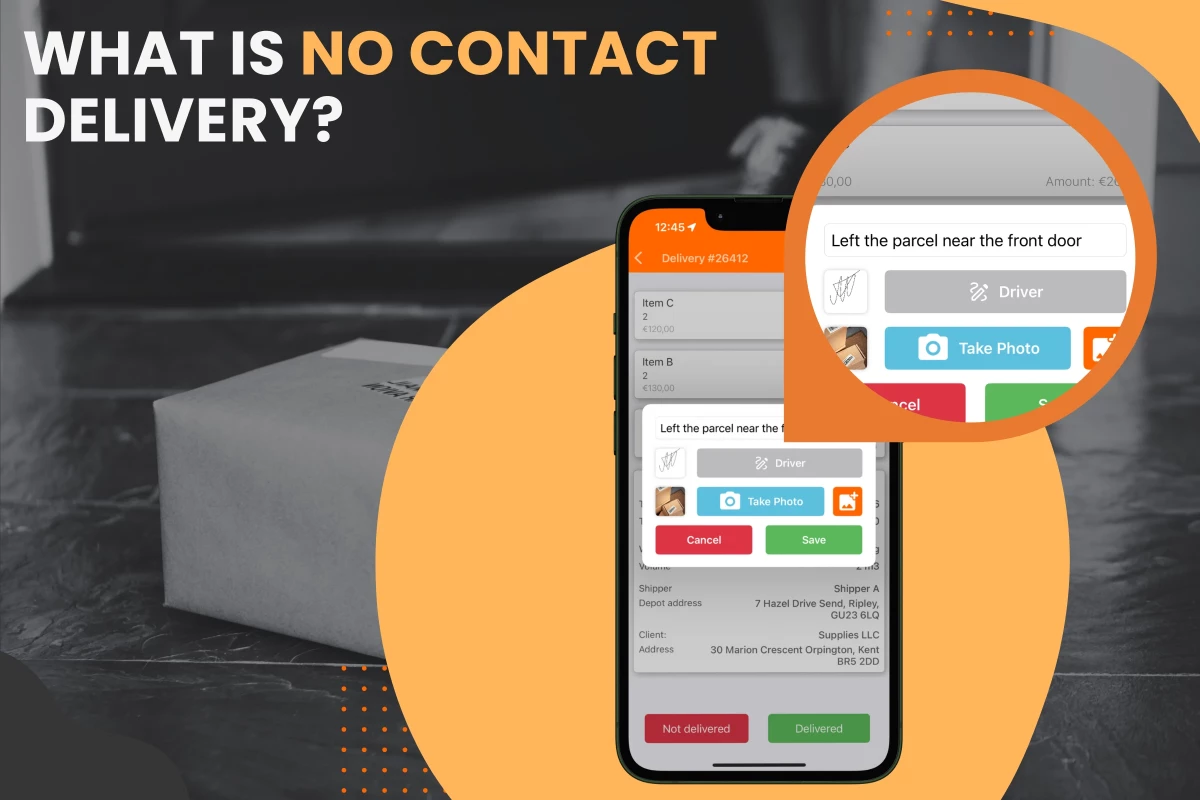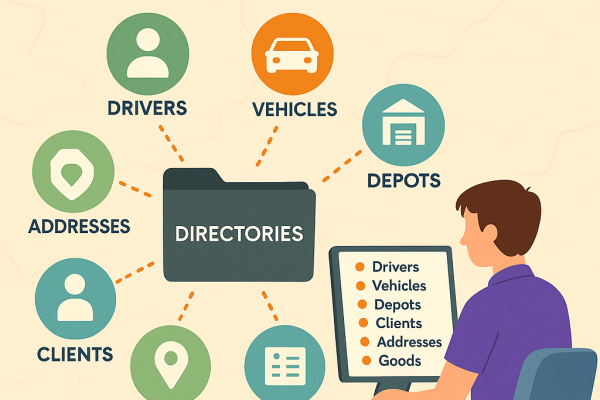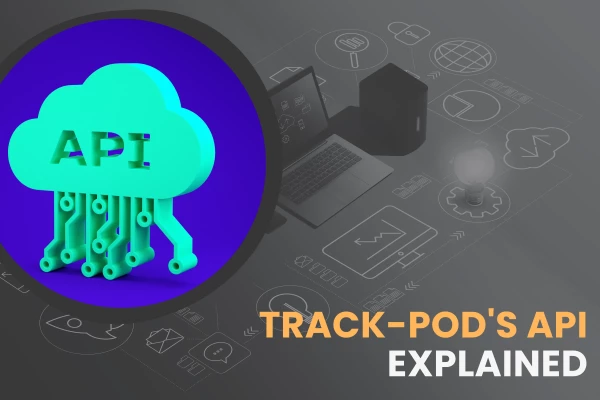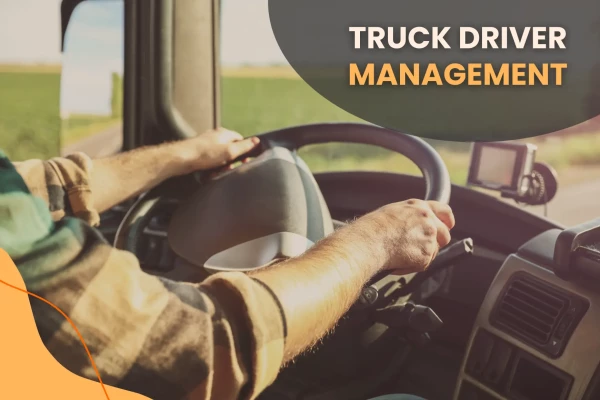What is no contact delivery?

by
Mike Foster
March 01, 2024
In the hustle and bustle of our world today, people are relying on delivery services more and more. With the advances in technology, drivers are now able to drop off goods at the customers’ premises, take a quick photograph as proof of delivery, send it with an electronic POD to the customer, and leave for their next assignment.
This is the essence of no contact delivery: speed, convenience, and efficiency. By minimizing human interaction, companies save time and money, and neither the driver nor the customer are exposed to the possibility of infection, be it ever so slight. It’s also convenient for customers who are not able to take delivery right away but have a safe drop-off area.
Online shopping is on the increase, and the need for fast, efficient deliveries has taken the logistics world by storm. Customers appreciate good service, and their privacy and safety are often a deciding factor. Research shows that more and more people are asking for no contact delivery, meaning that if your company does not offer this service, you may be losing out on orders.
What is no contact delivery?
No contact delivery means different things to different people. It may be your local pizza delivery, where you pay online, and your pizza gets dropped off. The delivery person leaves your pizza on the doorstep, rings the doorbell, and disappears into the night.
Businesses have smart desks for contactless receipts, and courier companies make use of a hub containing smart boxes, where customers collect packages at their own convenience, and there is no need to wait in a queue.
No contact delivery had a slow start in the years leading up to 2020. It was a concept that applied mainly to food deliveries. When COVID-19 hit in early 2020, there was a sudden and urgent need to distance ourselves and maintain contact only with the people we really needed to.
The United Nations Conference on Trade and Development (UNCTAD) released figures showing that the number of people with internet access who made purchases online in 2019 was 53% before the pandemic.
This figure increased to 60% between 2020 and 2021, with the greatest rises taking place in the developing countries. Along with this increase, the need for no contact deliveries escalated exponentially as online shoppers tried to isolate themselves and their families from the devastating effects of the pandemic.
In 2021, research revealed that 65% of customers interviewed were of the opinion that contactless services tied in with their idea of a great customer experience.
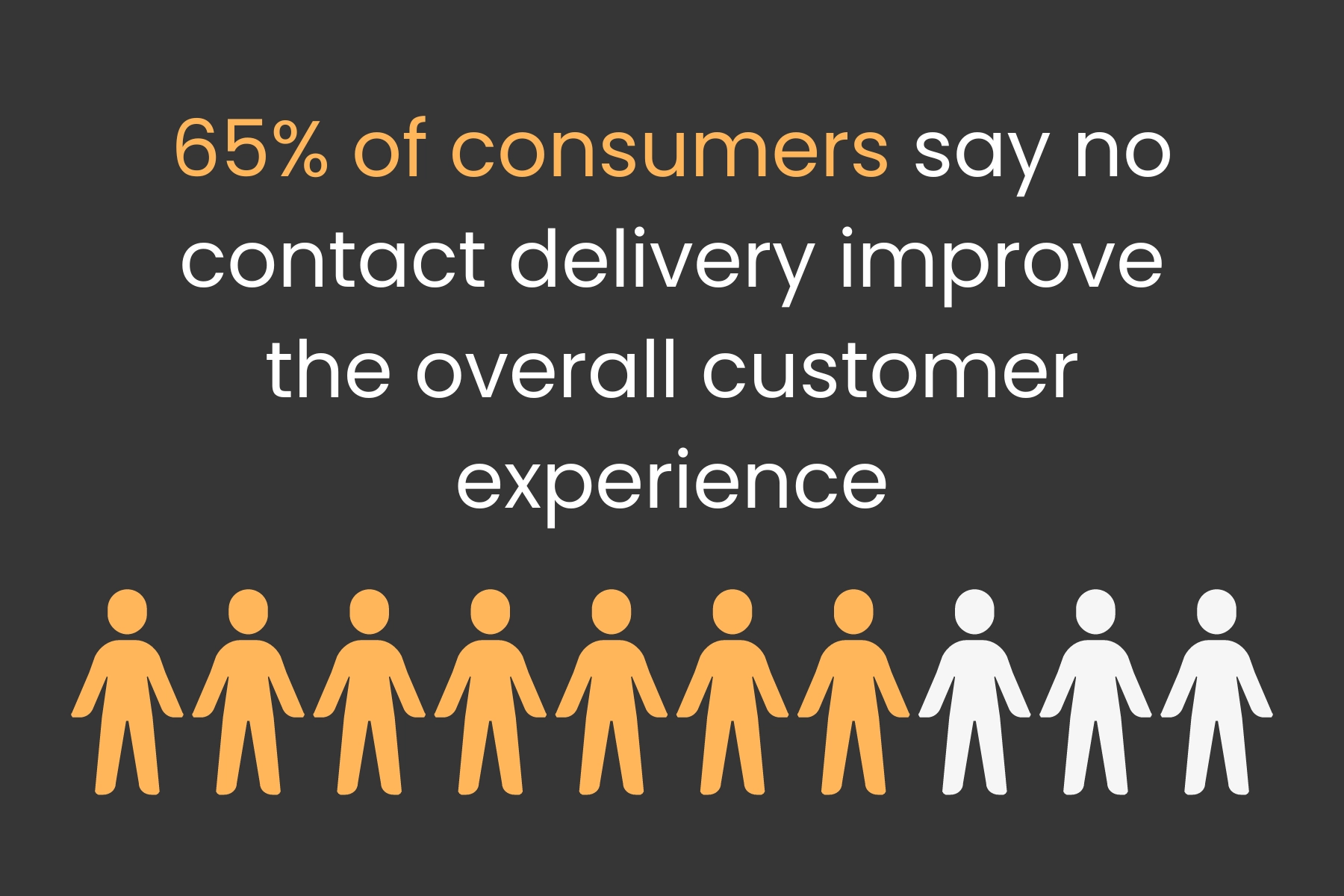
Fortunately, the need for isolation has dissipated, but we have become more aware of our personal space and our need to avoid the possibility of illness.
No contact delivery also means convenience for many individuals and businesses. Provided there is a safe place to leave deliveries, people don’t have to be on the spot to receive their parcels.
The process is a lot quicker for both the recipient and the driver, and it means that drivers should be able to fit a few extra deliveries into their working day.
The mechanics of no contact delivery
With contactless deliveries, the customer is notified in advance of the expected time of delivery. They are able to track the progress of their delivery from the time it leaves the warehouse until it arrives at their premises via a number of shipping notifications sent by the courier company.
The customer may give specific instructions as to a safe place where the driver can place the parcel.
In contactless deliveries, the driver drops the goods off, takes a photograph with a mobile phone, and sends the customer a notification that the delivery has been made.
The electronic proof of delivery (ePOD) is made available to both the customer and the dispatching company and includes the photograph with the notification. The dispatching company, the driver, and the customer have peace of mind as the process has been tracked and recorded with minimum human contact.
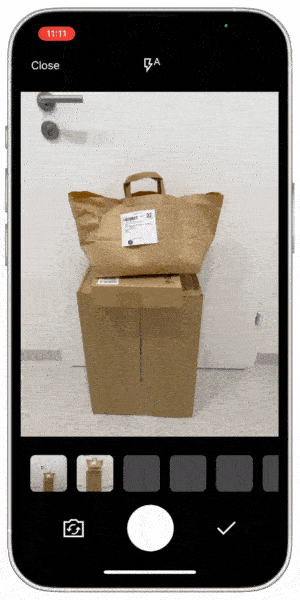
Proof of delivery is crucial
In business, an ePOD document is crucial in the delivery process.
- It confirms the delivery of the specific items ordered by the customer.
- It confirms the receipt of the items by the customer.
- It confirms that the items were checked and are in good condition.
If there is a discrepancy between what was ordered and delivered, or if there is a return due to incorrect or damaged stock, such software solutions as the Track-POD Driver App allow the driver to capture different statuses and quantities delivered in the case of shortages and non-deliveries.
What are the benefits of no contact delivery?
The time that it takes for the driver to drop the boxes off, take the photograph, and transmit the news to the customer is minimal.
In larger companies, a queue of drivers often waits in the receiving area for someone to check their documents, check the delivery, and sign it off. This causes delays in the driver’s busy schedule, and it means pushing the expected time of arrival (ETA) out for any subsequent deliveries that the driver has to make, impacting the number of deliveries possible in a day.
Therefore, dispatchers must build extra contingency time into their drivers’ schedules to compensate for these long waits. It may mean a longer shift for the driver and additional wages or utilizing an extra vehicle and driver to execute the backlog in deliveries.
In a competitive business environment, customers will take their business elsewhere if they are unhappy with delivery times.
There is no doubt that customers who opt for a no contact delivery option save themselves and the logistics company an immense amount of time, and there is a cost reduction all around.
With no contact deliveries in place, ETAs become more reliable, and customers are satisfied with quicker delivery times. Contactless deliveries also mean fewer risks in terms of the safety of customers, drivers, and cargo.
A huge benefit of contactless delivery is the savings on paperwork and administration, as testified by Imperial Dade Canada, a global Fortune 500® company.
The paperwork involved in the typical large delivery volumes was time-consuming for customers to sign off, took hours for drivers to process back at the depot, and was a nightmare for accounting personnel to reconcile. The introduction of ePODs has saved the company time and costs and has reduced frustration levels to a minimum for management, drivers, and customers alike.

The ability to track deliveries from start to finish means that if there is a problem, such as a holdup in traffic, communication channels are open, and the customer is alerted to the problem and given a new ETA.
Costs, ETA, and convenience aside, the last mile delivery option is the most carbon-intensive and least energy-efficient section of the distribution process, according to an article published by the US National Library of Medicine.
Given the current trends in online shopping, the carbon emissions relating to the distribution of these products have become a concern. The use of digital technology in the logistics environment, and no contact delivery in particular, helps to reduce our carbon footprint quite substantially, as we reduce the amount of paper documentation required and plan our routes more efficiently.
Challenges and concerns of using no contact delivery
Where would we be in life if there were no challenges to overcome? Each new scenario comes with a problem or two, and no contact deliveries are no exception.
Communication is perhaps the most important criterion in the delivery process. Communication between dispatch personnel, drivers, and customers means that problems can be solved as they occur.
Loss of internet connection:
This is a reality as drivers navigate their way through areas with poor internet connectivity. Track-POD’s mobile application will re-synchronise the data once the driver regains connection with the server, so there is no risk of losing information such as POD details, and the customer is unlikely even to realize that there has been a break in communication.
Leaving packages in a safe location:
Communication is key to ensuring the safety of goods. If the customer is not available to take delivery personally, they may have specific instructions about where to leave the package. Track-POD’s Driver App relays these instructions to the driver, who will photograph the package once it is placed in the prearranged location and record it as proof.
The synergy of no contact delivery and Track-POD software
Track-POD’s last-mile logistics software enables the optimization of delivery schedules, selecting the shortest and most efficient route. As the stock is loaded onto the delivery vehicle, an app on the driver’s phone is updated with the route details and the customer’s specific drop-off instructions.
The Track-POD last mile software includes an efficient route planner, vehicle tracking, and a customizable customer portal, enabling customers to track their delivery from start to finish. In addition, the mobile features of the driver’s app mean that the customer receives real-time updates on the progress of the delivery.
When the stock arrives at its destination, the customer will receive a notification of delivery, with a photograph depicting the exact location of the stock.
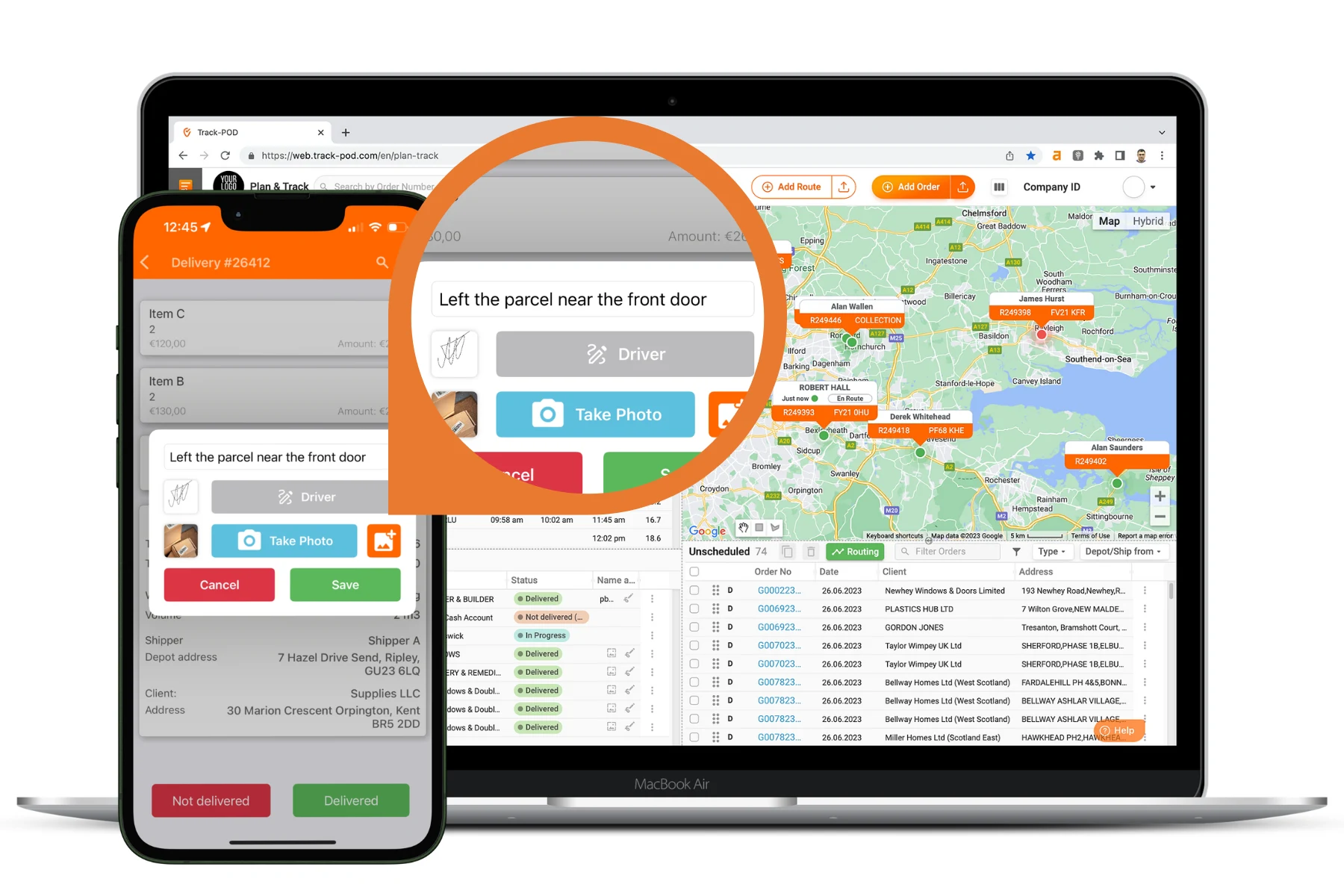
Future trends in no contact delivery
Internet of Things (IoT) and autonomous vehicles
IoT improves the flow of data between devices and systems, enabling vehicles to be self-monitoring and to warn logistics teams about potential maintenance problems before they happen.
Onboard telematics is the communication and storage of the vehicle’s GPS data and other vehicle-specific data such as engine diagnostics, vehicle activity, and the location of the vehicle. It has the potential to optimize delivery routes in real time, changing the scenario for both logistics companies and drivers.
Autonomous vehicles
Driverless vehicles, that is, autonomous vehicles, will eliminate human error with features like lane-keeping and automatic braking. While this technology is still in the test phase, many logistics companies hope that introducing autonomous vehicles will minimize accidents and improve delivery times.
Driverless vehicles will also place a new slant on no contact deliveries. It would mean, though, that a human being or robot would have to be on the receiving side.
Blockchain technology
Blockchain is a decentralized digital ledger system that enables the capture of transactions without the ability to change them. It promotes transparency, reducing the possibility of fraud.
Blockchain can simplify documentation. For example, companies use smart contracts that are stored on the blockchain system and activated when predetermined conditions are met. Logistics companies and their clients use this function to trigger an automatic payment once the goods have been delivered.
In the case of contactless deliveries, having an ePOD that is almost instantaneous and a payment trigger in response could speed up the payment process considerably.
Robotic process automation (RPA)
The use of robotics in the final delivery stage is particularly suited to no contact deliveries, especially for smaller cargo items.
Between 2022 and 2030, the global drone delivery market is forecast to grow at a compound annual growth rate (CAGR) of 49 percent. Drones have GPS technology, which enables them to do accurate parcel drop-offs and capture the process on video, while logistics personnel have a remote view of what is happening and can intervene if necessary. The use of robotics is in its early stages, but if it takes off, it could change the face of logistics in a big way.
3D Printing
3D printing can add a new slant to contactless deliveries by printing and producing the product at the point of delivery. This technology would eliminate the need to transport bulky products and minimise the possibility of damage, thus saving transport and storage costs.
Track-POD: Convenience, efficiency, and customer satisfaction
No contact delivery is, therefore, a convenient and time-efficient method of delivering goods to customers without any physical human interaction taking place. All communications are done via mobile phone apps, emails, and user dashboards.
It improves efficiency, reduces delivery costs, and keeps customers happy.
The convenience of online shopping has meant an escalation in deliveries across cities and countries, and the need for efficient and timely deliveries has grown along with the trend.
We’ve recovered from COVID-19, but the need for safety is still a priority—it’s a choice that customers make, and it seems the convenience and security of no-contact delivery are here to stay.
Track-POD’s last mile delivery software facilitates every aspect of no contact customer service, from optimizing the delivery routing process and tracking your vehicles to transparent customer portals and real-time communication. Why not access our free trial option today and assess the benefits to your business and your customers?
About The Author
Mike Foster
A dynamic writer whose passion for technology and Software as a Service (SaaS) is the driving force behind his compelling work.

